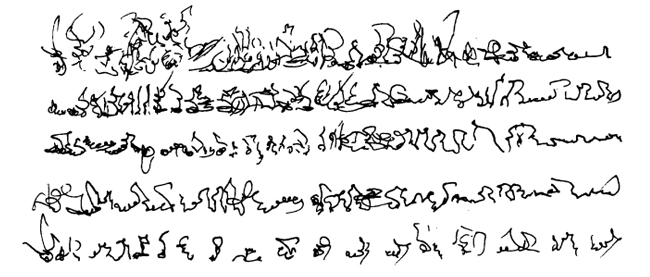Asemic writing is a wordless open semantic form of writing. The word asemic means “having no specific semantic content”.
All writing does not just contain semantic information. It also contains aesthetic information when seen as a shape or image, and emotional information such as a graphologist would analyze. Because it eliminates the semantic information, asemic writing brings the emotional and aesthetic content to the foreground.
By contrast, email is writing almost devoid of aesthetic and emotional content apart from what the words contain. Asemic works play with our minds, enticing us to attempt to read them. Some asemic works make the viewer hover between reading as a text and looking as a picture.
Illegible, invented, or primal scripts (cave paintings, doodles, children’s drawings, etc.) are all influences upon asemic writing. But instead of being thought of as mimicry of preliterate expression, asemic writing can be considered as a postliterate style of writing that uses all forms of creativity for inspiration.
Some asemic writing has pictograms or ideograms, which suggest a meaning through their shape. Other forms are shapeless and exist as pure conception.
Asemic writing has no verbal sense, though it may have clear textual sense. Through its formatting and structure, asemic writing may suggest a type of document and, thereby, suggest a meaning. The form of art is still writing, often calligraphic in form, and either depends on a reader’s sense and knowledge of writing systems for it to make sense, or can be understood through aesthetic intuition.
It can also be seen as a relative perception, whereby unknown languages and forgotten scripts provide templates and platforms for new modes of expression. Asemic writing occurs in avant-garde literature and art with strong roots in the earliest forms of writing.
